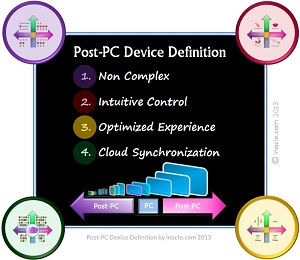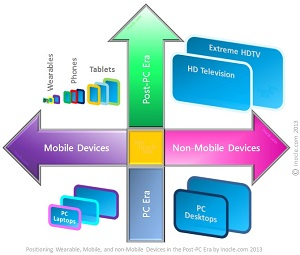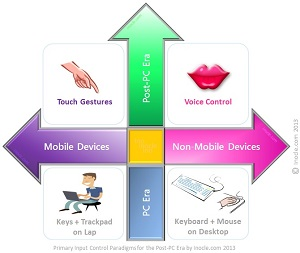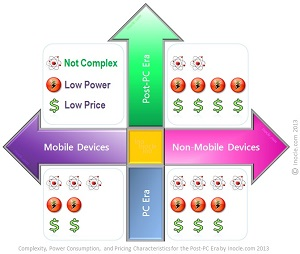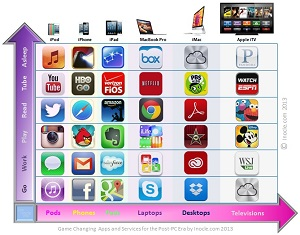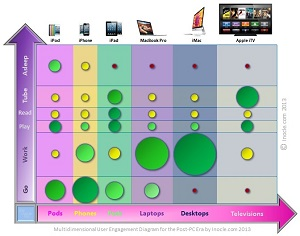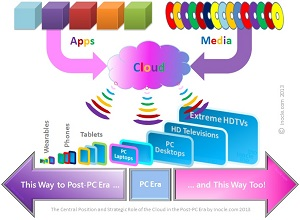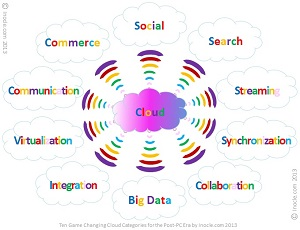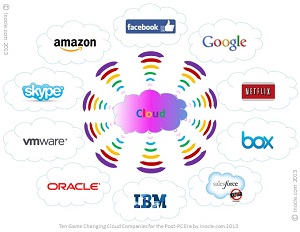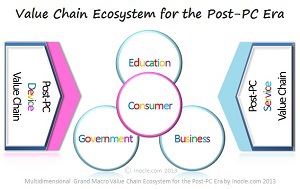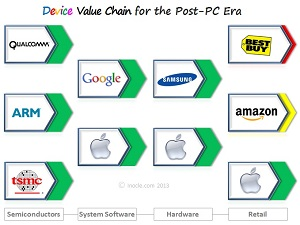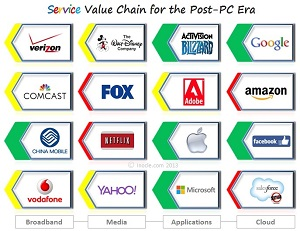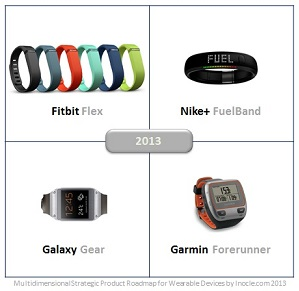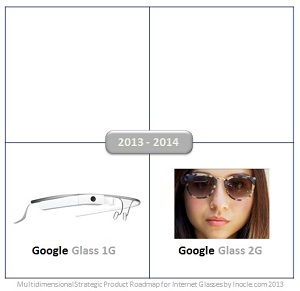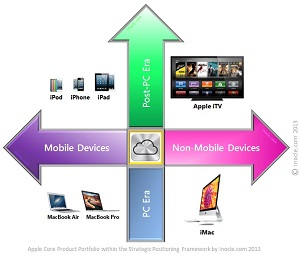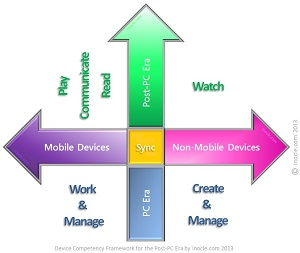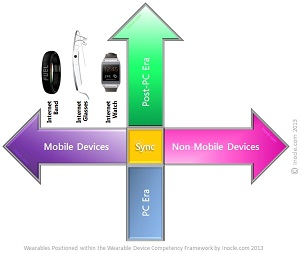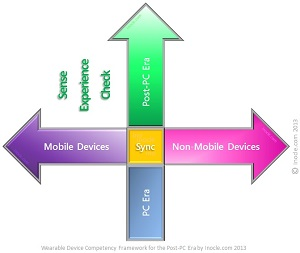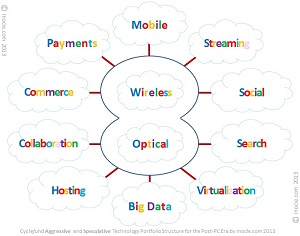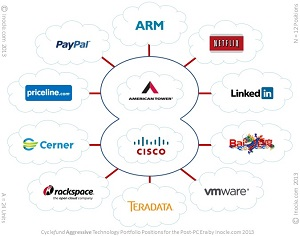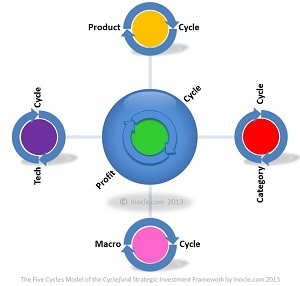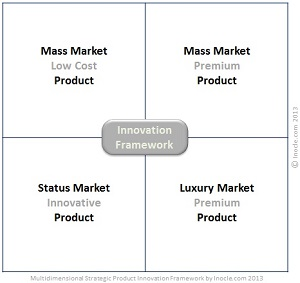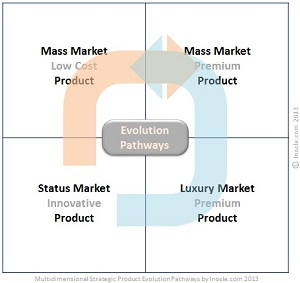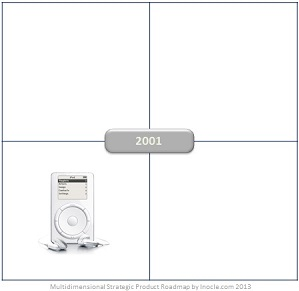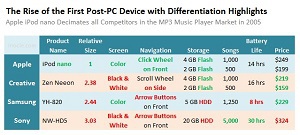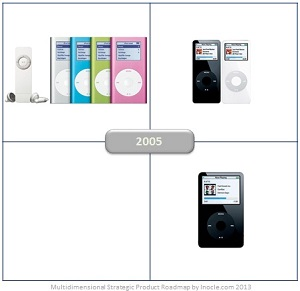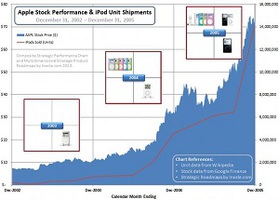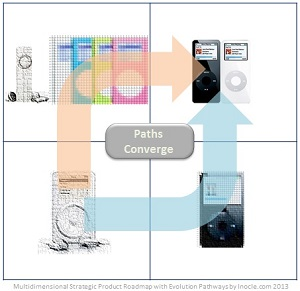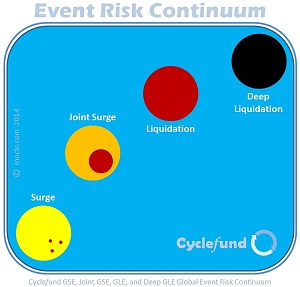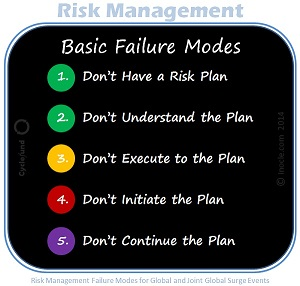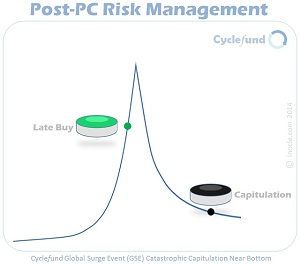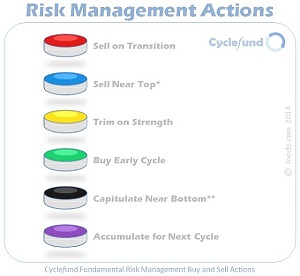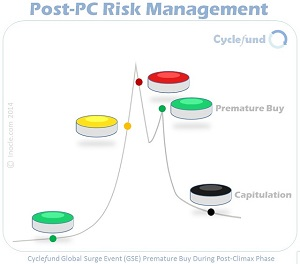Frequently Asked Post-PC Questions
The purpose of this section is to provide answers to specific questions related to a variety of post-PC topics, including post-PC devices, applications or apps, and cloud services; post-PC ecosystems, service value chains, and device value chains; post-PC wearables, Internet glasses, voice-controlled intelligent agents, and multiscreen solution suites; and post-PC portfolios, portfolio structures, strategic investments, and risk management. Questions regarding Apple post-PC competitive strategies, spanning Apple iPod, iPhone, iPad, and prospective iFamily product lines will also be addressed.
We organize our post-PC questions and corresponding answers below by post-PC topic areas, including basic questions, cloud questions, value chain questions, wearable computing questions, solution suite questions, strategic investing questions, case study questions, and risk management questions. For each question posed, we provide both a visual answer in the form of a graphical diagram or illustration and a textual answer in the form of a summarization paragraph plus a source reference whereby the reader can uncover addition details directly pertaining to his or her question.
Basic Post-PC Questions
Question 1: What is a post-PC device?
Answer 1: A post-PC device is an intuitive, non-complex, seamlessly integrated hardware and software machine with a highly
optimized user experience and cloud synchronized software apps, media content, and object data. (source: iGlass page of inocles.com)
Question 2: What are some examples of post-PC devices?
Answer 2: Examples of post-PC devices include wearable mobile devices, such as Internet bands, watches, and glasses, non-wearable mobile
devices, such as media players, smartphones, and tablets, and non-mobile devices, such as smart high definition televisions, smart ultra HD TVs, and smart extreme definition
TVs. (source: iGlass page of inocles.com)
Question 3: How is a post-PC device different than a PC device?
Answer 3: Unlike relatively-complex, general-purpose PC devices that are primarily controlled via an intermediated mouse-icon paradigm, non-complex,
highly-optimized post-PC devices are primarily controlled via a disintermediated touch-gesture or voice-control paradigm. (source: iGlass page of inocles.com)
Question 4: What are the most popular post-PC apps?
Answer 4: The most popular post-PC applications, or apps, and services include media content and streaming apps and services, such as Apple iTunes, Pandora, Netflix, Google YouTube, HBO GO,
and Rovio Angry Birds, communication apps and services, such as Apple iMessage, Facebook Messenger, Google Gmail, Microsoft Skype, Google Hangouts, and Apple FaceTime,
social networking apps and services, such as Facebook, Facebook Instagram, Twitter, LinkedIn, and Sina, collaboration apps and services, such as Salesforce.com, Workday, Evernote,
Apple iWork, and Microsoft Office 365, creative apps and services, such as Adobe Creative Cloud, Apple iPhoto, and Apple iMovie, synchronization apps and services, such as Apple
iCloud, Google Drive, Microsoft SkyDrive, Box, Dropbox, search and navigation apps and services, such as Google, Google Maps, Microsoft Bing, Yahoo, and Baidu, and reading and surfing apps
and services, such as Amazon Kindle, Adobe Acrobat, Apple Safari, and Google Chrome. (sources: iPhone page and Steve Jobs page of inocles.com)
Question 5: What do users do with their post-PC devices?
Answer 5: In contrast to conventional general-purpose PCs which are ideally suited for work-oriented tasks, such as creating and producing documents, post-PC
devices are individually and collectively optimized for life-oriented tasks, such as playing, communicating, reading, and watching while at home, on the go, at work, at school,
or out on the town. (source: iPhone page of inocles.com)
Post-PC Cloud Questions
Question 6: Why is the cloud so important to post-PC users?
Answer 6: In contrast to traditional PCs that are typically equipped with a large local storage drives, post-PC devices are optimized for storage efficiency and
therefore inherently rely on the cloud for data storage and access to
vast troves of application and media content.
In addition, since all of a user's post-PC devices natively point to the cloud, the cloud itself can efficiently determine the data and content differences across devices and automatically and
seamlessly synchronize all relevant data, settings, contacts, messages, email folders, calendars, documents, photos, videos, application programs, and media content, including music, music videos,
podcasts, videos, TV shows, and movies. (source: Steve Jobs page of inocles.com)
Question 7: What are post-PC cloud services?
Answer 7: Post-PC cloud services include social networking services, search and navigation services, streaming media services, synchronization and
storage services, collaboration and productivity services, big data and analytics services, integration and middleware services, virtualization and hosting
infrastructure services, communication and messaging services, and commerce and payment services, many of which power and provide cloud services directly or
indirectly to the post-PC apps described in Question and Answer 4 above. (source: Steve Jobs page of
inocles.com)
Question 8: Who are the leading providers of post-PC cloud services?
Answer 8: Leading companies providing post-PC cloud services include Facebook (social networking), Google (search and navigation), Netflix (streaming media), Box (synchronization and
storage), Salesforce.com (collaboration and productivity), IBM (big data and analytics), Oracle (integration and middleware), VMware (virtualization and hosting infrastructure), Microsoft Skype
(communication and messaging), and Amazon.com (commerce and payments). (source: Steve Jobs page of inocles.com)
Post-PC Value Chain Questions
Question 9: What is a post-PC ecosystem?
Answer 9: A post-PC value chain ecosystem comprises a multilayered network of post-PC device producers and post-PC service producers serving, profiting from, and
monetizing post-PC consumer customers and post-PC enterprise customers, including business enterprises, government enterprises, and education
enterprises. (source: iPad page of inocles.com)
Question 10: What is a post-PC device value chain?
Answer 10: A post-PC device value chain consists of online and offline retail companies, such as Amazon.com, Best Buy, and Apple Stores, hardware device companies,
such as Samsung Electronics and Apple, system software companies, such as Google and Apple, and semiconductor design and manufacturing companies, such as ARM Holdings, Qualcomm, and
Taiwan Semiconductor Manufacturing.
The purpose of the post-PC device value chain is to produce post-PC devices for post-PC consumer customers and post-PC enterprise customers in accordance with the framework of the post-PC ecosystem
described in Question and Answer 9 above. (source: iPad page of inocles.com)
Question 11: What is a post-PC service value chain?
Answer 11: A post-PC service
value chain consists of wireless and wired broadband communication companies, such as Verizon, Comcast, China Mobile, and Vodafone, media content and streaming companies, such as
Disney, Twenty First Century Fox, Netflix, and Yahoo, application software companies, such as Activision, Adobe, Apple, and Microsoft, and cloud service companies, such as Google,
Amazon.com, Facebook, and Salesforce.com.
The purpose of the post-PC service value chain is to provide post-PC services for post-PC consumer customers and post-PC enterprise customers in accordance with the framework of the post-PC ecosystem
described in Question and Answer 9 above. (source: iPad page of inocles.com)
Post-PC Wearable Computing
Questions
Question 12: What is a post-PC wearable?
Answer 12: Post-PC wearable devices include Internet bands, such as Nike+ FuelBand and Fitbit Flex, Internet watches, such as Samsung Galaxy Gear, Garmin Forerunner,
and the prospective Apple iWatch, and Internet glasses, such as Google Glass First Generation (1G), Google Glass Second Generation (2G), and the prospective iGlass Air or
iGlass Pro. (sources: Steve Jobs page of inocles.com and Definition, Examples, Icons, and Vision pages of inocle.com)
Question 13: What are post-PC Internet glasses?
Answer 13: Post-PC Internet glasses are modern eyeglasses equipped with an embedded optical display system that enables the transmission of data, information, and media
content directly from the Internet to a user's eye or eyes.
Internet glasses are also typically equipped with digital audio and digital imaging sensors that allow a user to take still photos and record live videos of important life
events, which a user may choose to save locally or to the cloud; email to colleagues, friends, and family; post to social networking sites, such as Facebook or Twitter; upload to
video sharing sites, such as YouTube; or stream in real time to video communication services, such as Skype or Google Hangouts. (sources: Definition page and Vision page of
inocle.com)
Question 14: How are post-PC Internet glasses used?
Answer 14: Post-PC Internet glasses are used to instantly access information from the Internet hands-free and share real world life experiences with remote friends and family
members.
Examples include a married couple sporting Internet glasses to learn about their surroundings as they travel through and around foreign lands; an architect
sporting Internet glasses to access blueprint diagrams while inspecting a construction site; a mother sporting Internet glasses while shopping at a grocery
store and receiving a notification from her smart refrigerator appliance that she needs a gallon of milk; and a granddaughter sporting Internet glasses to
share her birthday party festivities with her remote grandmother in real time. (source: Examples page of inocle.com)
Question 15: How do post-PC Internet glasses work?
Answer 15: Single-lamp post-PC
glasses are configured with a single compact optical display that projects images containing information from the Internet directly upon a relatively small portion of a user's retina,
leaving the remaining portion of the retina free to capture essentially the full field of view of the user's surroundings.
Dual-lamp post-PC Internet glasses, such as those shown in the diagram above, work the same way but are configured with two optical displays, thereby doubling the power of the interaction
experience by enabling the user, for example, to instantly access information from the Internet in one display and simultaneously share life experiences with remote contacts via the second display.
(source: Definition page of inocle.com)
Question 16: What is a post-PC voice agent?
Answer 16: A post-PC voice agent is an intelligent personal digital assistant that is embedded in a post-PC device, such as a pair of Internet glasses or other wearable device or a
smartphone or other non-wearable device, for the principal purpose of responding to user voice requests for instant information and immediate action.
This is especially helpful in situations where the user's hands are occupied by other more important tasks (such as walking, jogging, biking, driving, flying, jumping; hiking, climbing, skiing,
fishing, golfing, playing, gaming; cutting, drilling, stitching, writing, building, hosting, greeting, touring, inspecting, or other activity) which are non-conducive to hands-on device
control. (sources: Vision page and Icons page of inocle.com)
Post-PC Solution Suite
Questions
Question 17: What is a post-PC suite?
Answer 17: A post-PC solution suite comprises post-PC mobile devices, including media players, smartphones, and tablets, and post-PC non-mobile devices, including
smart high definition televisions, smart ultra HD TVs, and smart extreme definition TVs. Moreover, since the future of computing rests in the unification of the modern post-PC paradigm with the
traditional PC paradigm, a post-PC suite, by definition, must also include PC mobile devices, such as notebooks and laptops and PC non-mobile devices, such as desktops and
workstations.
A post-PC suite can be a pure homogeneous single-vendor solution as shown in the diagram above or a mixed
heterogeneous multi-vendor solution. (sources: Post-PC Suite page of
cyclefund.com and iGlass page of inocles.com)
Question 18: What is a post-PC wearable
suite?
Answer 18: A post-PC wearable solution suite comprises post-PC wearable mobile devices, such as Internet bands, Internet glasses, and Internet watches. A post-PC wearable suite can be a pure homogeneous single-vendor solution or a mixed heterogeneous multi-vendor solution as shown in the diagram above.
Post-PC Strategic Investing
Questions
Question 19: What is a post-PC portfolio structure?
Answer 19: A post-PC portfolio structure is defined as a set of one or more game-changing post-PC categories. These game-changing categories are also referred to as killer post-PC categories. As show in the diagram above, examples of killer post-PC categories include mobile, payments, streaming, commerce, wireless, social, collaboration, optical, search, hosting, virtualization, and big data. (source: Post-PC Portfolios page of cyclefund.com)
Question 20: What is a post-PC portfolio?
Answer 20: A post-PC portfolio consists of a set of game-changing post-PC companies that collectively span the set of game-changing post-PC categories defined by
its underlying post-PC portfolio structure. These game-changing companies are also referred to as killer post-PC
companies.
As shown in the diagram above, examples of killer post-PC companies include ARM Holdings, eBay (PayPal), Netflix, Priceline.com, American Tower, LinkedIn, Cerner, Cisco Systems, Baidu, Rackspace,
VMware, and Teradata, which collectively span mobile, payments, streaming, commerce, wireless, social, collaboration, optical, search, hosting, virtualization, and big
data post-PC categories, respectively. (source: Post-PC Portfolios page of cyclefund.com)
Question 21: What are post-PC cycles?
Answer 21: Post-PC cycles include post-PC technology, category, product, and profit cycles. Post-PC cycles serve as equity catalysts and correlate strongly with post-PC investment
returns, and therefore a solid understanding of these cycles is a prerequisite for formulating successful post-PC investment strategies.
One additional cycle that is not a post-PC cycle, but has the ability to dramatically affect all post-PC cycles is referred to as the macro cycle, which under certain adverse global economic
and political conditions can be subject to high-risk, high-impact global liquidation events and deep global liquidation events, where most or all paper-based financial assets are
massively devalued over relative short periods of time, as investors flee to liquidity. (source:
Post-PC Portfolios page of cyclefund.com)
Question 22: What is the post-PC innovation framework?
Answer 22: The Cyclefund strategic innovation framework is an analytical tool for understanding, mapping, and predicting the introduction and evolution of a mass-market
technology product over time or a family of mass-market products over time. The post-PC innovation framework is an application of the strategic innovation framework specifically to the
introduction and evolution of a post-PC mass-market product over time (such as the iPod media player) or a family of mass-market products over time (such as the iFamily post-PC
suite). (source: Steve Jobs page of inocles.com)
Question 23: What are post-PC evolution pathways?
Answer 23: Cyclefund strategic evolution pathways represent unique competitive approaches used by leading companies for establishing a dominant position over time in a new, emerging, or formerly established market space. Post-PC evolution pathways represent unique competitive approaches used by leading post-PC companies (such as Apple, Google, and Samsung) for establishing a dominant position over time in a post-PC space (such as media players, smartphones, tablets, smart televisions, and smart suites). (source: Steve Jobs page of inocles.com)
Post-PC Case Study
Questions
Question 24: What was the first post-PC device?
Answer 24: The first post-PC device was the Apple iPod introduced in late 2001. The first iPod met all of the criteria required to be classified as a bona fide post-PC device:
1) simple, easy-to-use, non-complex device (iPod hardware), 2) intuitive, natural primary control mechanism (iPod circular scroll wheel), 3)
focused, highly-optimized user experience (iPod software for playing music), and 4) automatic, seamless content synchronization (Apple FireWire). (source: iPod page of
inocles.com)
Question 25: How did Apple leapfrog the competition in 2005?
Answer 25: Steve Jobs and his team at Apple crushed all non-post-PC competitors in the digital media player market in 2005 with the introduction of the Apple iPod nano. With its
impossibly small size, vivid color screen, intuitive navigation wheel, and non-rotating flash storage, the Apple iPod offered customers a set of features unmatched by any competitors at an
affordable price, enabling Apple to achieve the dominant mas-market, premium-product position in the portable media player market, as shown in the diagrams
above. (source: iPod page of inocles.com)
Question 26: Why did Apple stock price soar in 2005?
Answer 26: The price of Apple stock rose dramatically in 2005 because Apple competitively dominated the portable media player market by occupying the three most important quadrants of the
post-PC innovation framework via three distinct post-PC evolution pathway strategies: 1) an orange-path evolution strategy emphasizing core competencies in miniaturization,
scale, and cost control that enabled Apple to dominate the mass-market low-cost product quadrant; 2) a blue-path evolution strategy emphasizing core competencies in
precision manufacturing, display screen technologies, and user interface technologies that allowed Apple to dominate the luxury-market premium product quadrant; and 3) a
converged-path or collision path evolution strategy bringing together for the first time, years ahead of the competition, core competencies gained from Apple's previously
independent orange and blue path evolution strategies that thrust the company into the dominant position within the highly coveted mass-market premium product quadrant.
In a nutshell, the competition had no time to react to Apple's converged-path evolution
strategy, which produced the hitherto impossibly small, intuitive, and vivid iPod nano in 2005. The game was over. Apple had won. Competitors were surprised. Financial markets were also surprised,
yet very pleased. The stock roared. And the company incontrovertibly cemented its position as the dominant post-PC player of the day. (sources: iPod page and Steve Jobs page of
inocles.com)
Post-PC Risk Management Questions
Question 27: Outside of a global liquidation event (GLE) or Deep GLE, what is the greatest risk faced by post-PC
investors?
Answer
27: The greatest non-GLE risk for post-PC investors is the failure to properly act before or immediately after the onset of a post-climax phase of a global surge
event (GSE) or Joint GSE. See the iFund page of this site for formal definitions of GSE and Joint GSE events.
Question 28: What are the five basic reasons why investors fail to properly act during a post-climax GSE
transition?
Answer 28: The failure to properly act during a post-climax GSE transition typically occurs for one of five basic reasons, which can be expressed as modes of failure:
- The investor fails to have a risk management plan in place.
- The investor fails to understand the risk management plan.
- The investor fails to adhere to the risk management plan during execution.
- The investor fails to initiate the execution of the risk management plan.
- The investor fails to continue the execution of the risk management plan.
Investors can
avoid the first two modes of failure above by employing the Post-PC Risk Management Framework presented on the iFund page of this site. This framework is designed to ensure that
investors have a risk management plan in place which is easy to understand and simple to execute. The third failure mode is equivalent to neither having nor understanding a risk management plan. This
leaves the fourth and fifth failure modes, which we address in the subsequent Q & A sections.
Question 29: Of the five basic failure modes, which mode is the most challenging?
Answer 29: The fourth failure mode (failure to initiate) is the most challenging because highly-volatile equity market price dynamics during GSE transitions incite human emotions and
basic instincts that may cause investors to improperly delay the initiation of their risk management plans. We address this behavior pattern in the next Q & A section.
Question 30: How does a simple delay in initiating a risk management plan lead to a catastrophic sequence of cascading
delays?
Answer
30: An investor’s failure to initiate the execution of a well-designed and clearly understood risk management plan during the post-climax phase of a GSE can lead to a cascading progression
of delays as the investor adopts an irrational train of thought leading to increasingly poor investment decisions.
If not quickly arrested by the investor or by the investor’s financial advisor, this progression could prove to be financially catastrophic, as illustrated in the example event sequence
timeline below and its corresponding companion diagram above:
- During the late-surge phase of a GSE or Joint GSE, an investor buys in late (green button).
- An exogenous shock hits the global markets and causes volatility to spike higher.
- GSEs and Joint GSEs in late-surge phases transition to post-climax phases.
- Affected equities sell off precipitously on high volume over a brief window in time.
- The investor reviews the recent declines in his or her portfolio holdings.
- The sudden loss of wealth is unfathomable relative to its recent peak value.
- Hoping to get back to even, an instinct arises to wait for a rebound in prices.
- GSE equities and Joint GSE equity groups continue to fall precipitously in price.
- Momentum investors are out.
- Traders have gone short en masse.
- Growth investors are on the sidelines waiting for the next cycle.
- Value investors are waiting for a floor to be established.
- Deep value investors are waiting for a substantial (fifty-percent plus) price decline.
- At the same time, the investor is trapped in an illiquid financial vortex.
- On any short-lived relief rallies, the investor repeatedly fails to act.
- Instead, the investor clings to the mantra that it’s too late to sell.
- Meanwhile, the investor's holdings continue to decline over an intolerable period of time.
- The investor becomes discouraged, loses interest, and finally capitulates (black button).
- Deep value investors capitalize on this opportunity, and the next cycle begins.
Question 31: Of the five basic failure modes, which mode is the second most challenging?
Answer 31: The fifth failure mode (failure to continue) is the second most challenging because highly-volatile equity market price dynamics during GSE transitions incite human
emotions and basic instincts that may cause investors to improperly discontinue their risk management plans. We address this behavior pattern in the next Q & A section.
Question 32: How does discontinuing a risk management plan lead to poor financial performance?
Answer 32: An investor’s failure to follow through on the execution of a well designed, clearly understood, and properly initiated risk management plan during the post-climax phase of a GSE can lead to poor financial performance as the investor gets trapped in a volatile cycle of buying high and selling low, as illustrated in the example event sequence timeline below and its corresponding companion diagram above:
- An exogenous shock hits the global markets and causes volatility to spike higher.
- GSEs and Joint GSEs in late-surge phases transition to post-climax phases.
- The investor successfully initiates the risk management plan and sells (red button).
- Affected equities sell off precipitously on high volume over a brief window in time.
- On the first major relief rally, an instinct arises to believe that the worst is over.
- GSE equities and Joint GSE equity groups spike higher, but to lower relative highs.
- The investor abandons the risk management plan and buys back in (second green button).
- Momentum investors are out.
- Traders have gone short en masse.
- Growth investors are on the sidelines waiting for the next cycle.
- Value investors are waiting for a floor to be established.
- Deep value investors are waiting for a substantial (fifty-percent plus) price decline.
- GSE equities and Joint GSE equity groups plunge rapidly to lower relative lows.
- During this plunge, awareness arises that the worst is not over.
- The investor re-initiates the risk management plan and sells accordingly.
- The investor becomes enamored again by subsequent relief rallies.
- The investor becomes disillusioned once more by subsequent sharp declines.
- The investor is trapped in an oscillating vortex of lower relative highs and lower relative lows.
- Each cycle leads to continued declines in the value of the investor’s holdings.
- The investor becomes discouraged, loses interest, and finally capitulates (black button).
- Deep value investors capitalize on this opportunity, and the next cycle begins.
In summary, if
investors have a post-PC risk management plan that is well-designed, clearly understood, reliably adhered to, properly initiated, and not prematurely discontinued, the five basic failure modes
associated with risk management planning & execution during a post-climax global surge event (GSE) transition can be avoided.
Questions on Cyclefund Models, Frameworks, & Theories
Question 33: What is Cyclefund.com?
Answer 33: Cyclefund.com is a global online knowledge service that provides financial literacy and education resources to self-directed investors and private wealth
managers who prefer multiscreen access to knowledge graph entities using modern post-PC suites of cloud-connected smart devices, including wearables, such as smart watches and smart glasses,
smartphones, tablets, and Internet televisions, as well as traditional laptop and desktop personal computers, or PCs.
Question 34: What is Cyclefund (without the
.com)?
Answer 34: Cyclefund is a unified financial theory comprising numerous interdependent multidimensional frameworks and models designed to help self-directed
investors and private wealth managers identify strategic investment themes with long time horizons and disruptive growth potential through an intimate understanding of next-generation competitive
positioning strategies, innovation strategies, and evolution strategies used in the recent past and likely to be pursued in the near future by leading and emerging competitors during game-changing
global technology, category, product, and profit cycles.
Question 35: Who is the author of the unified Cyclefund
theory?
Answer 35: The author of the Cyclefund theory is Mark Cummings
PhD, head of Cyclefund Research.


